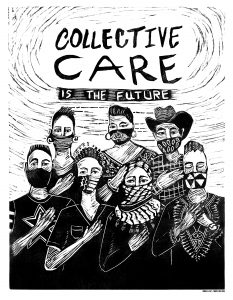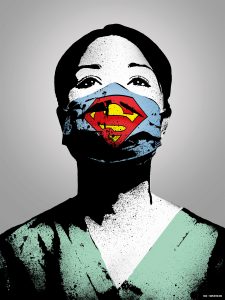by Steven Lacey, PhD
The challenge of public health has always been to reach members of our community where they are, rather than where we hope they are. Part of the solution to this challenge for public health practitioners is crafting stories–stories that manage to claim the attention and sympathy of a wide range of people while still communicating essential health information.

During the flu pandemic of 1918, public health officials faced many of the same challenges we encounter today: inadequate medical supplies, the fear of economic catastrophe, politicization of the disease, and a population suspicious of emergency restrictions. Many governmental and health leaders turned to art as a way to reach their fellow citizens to inform of the dangers of the flu and provide clear information on ways to stay safe from its ravages. Health-related artwork and public notices went up in towns and cities from San Francisco to New York.
Drawing on their propaganda experience during World War I, officials used memorable drawings and slogans like “Halt the epidemic! Stop spitting,” and “Coughs and Sneezes Spread Diseases – As Dangerous as Poison Gas Shells” to alert the public to the danger and provide a story of how to react.
The use of art as a way of conveying medical information to others is not a new idea. It’s no coincidence, for example, that the earliest anatomists were artists, nor that medical textbooks are filled with art in the form of diagrams, models, and examples. Art can reduce an idea to its most basic elements, and teach in a way that is impactful and lasting. Perhaps art’s greatest power, however, is to communicate important information across groups and, often, across time. It is eerie to look at the posters for the 1918 pandemic and see messages that resonate today—social distancing, maintaining mental health in quarantine, washing hands.
It is true that the world has changed fundamentally since 1918. Despite our technological advancement and the sophistication of our communication networks, we still have the basic challenge of getting our message heard among the disorientation and disinformation that COVID-19 has brought to our communities. Because our challenges are the same, we have the opportunity to utilize art in the same way to reach out to every citizen in memorable and effective ways.
Amplifer, a design lab that builds art with the express purpose of sharing the message of social causes, is one organization that has harnessed the power of art to tell a socially powerful story. The originators of the powerful “We the People” campaign of artwork that challenged the political narrative in 2016, Amplifier is currently inspiring artists to rise to the challenge of getting good health information about the COVID-19 pandemic to the people who need it the most.

Their Global Call for Art, issued at the beginning of this month, has generated thousands of entries from artists across the world. The art is clever, positive, inspiring, and conveys the most vital information society needs to remain committed to the COVID-19 response. What is more, these images are free to download and use wherever they may be useful.
As public health professionals, it can be difficult to connect with those outside of our discipline, who may not share our values, when we share information about this pandemic. But now more than ever we need everyone to have access to—and faith in—accurate public health information. Art can help bridge that gap, and thoughtful artwork with powerful health messages can sometimes bring about more social change than weeks of expert opinions in the news. That is why the Division of Public Health at the University of Utah has partnered with Amplifier to help supplement our efforts—both locally and internationally—to keep our citizens informed and safe.
Whatever challenges this pandemic has in store for us in the coming months, art will be a valuable tool in helping maintain the commitment to safety of our communities. I encourage you to make use of art as you do all the tools at your disposal.
Dr. Steven Lacey is Professor and Chief of the Division of Public Health at the University of Utah School of Medicine. A Certified Industrial Hygienist and Certified Safety Professional, Dr. Lacey is a Past President and a Fellow of the American Industrial Hygiene Association.
